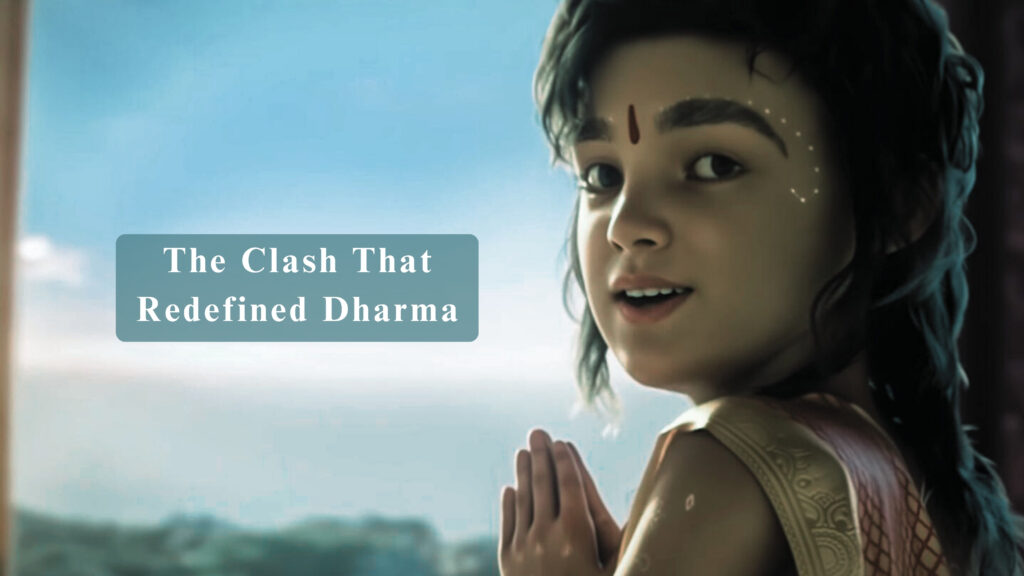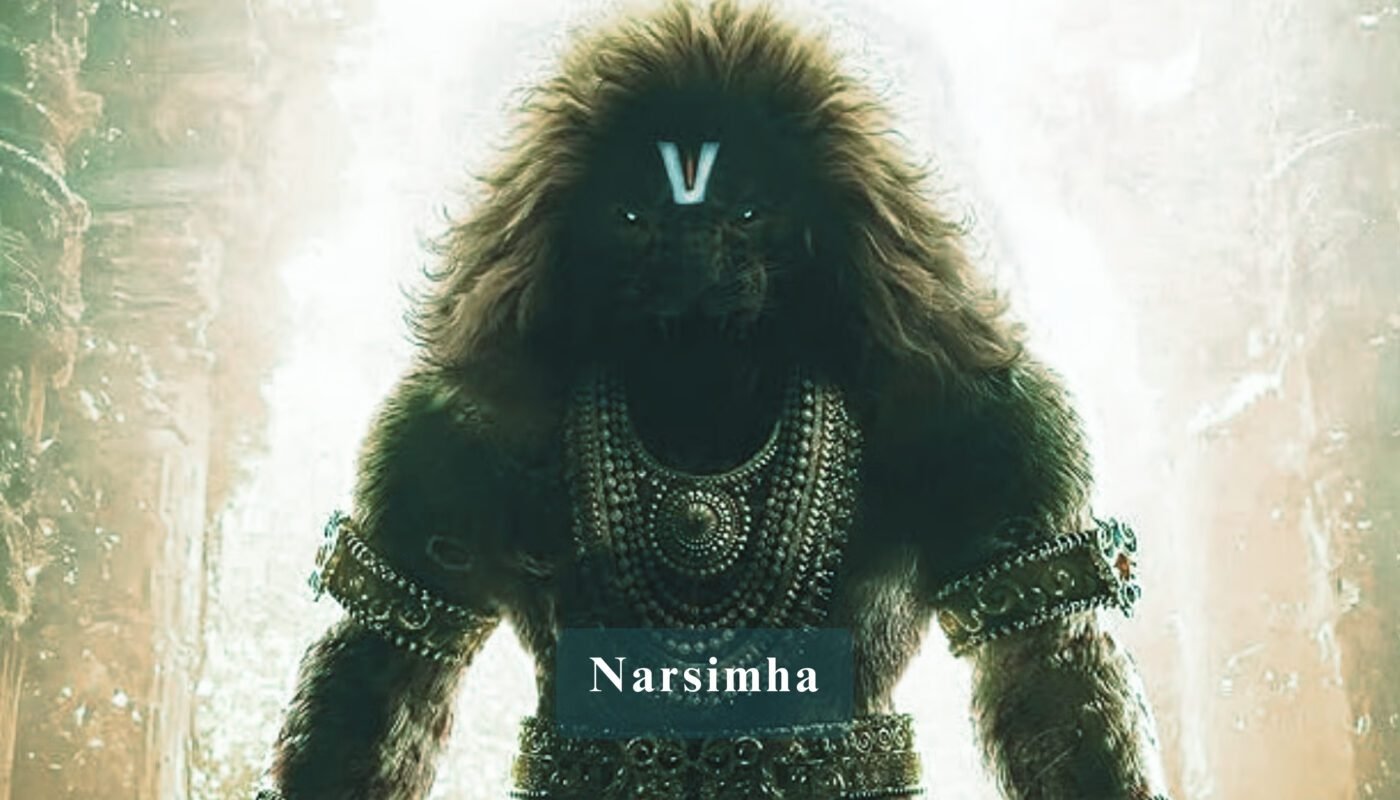When I walked out of the theater after watching Mahavatar Narsimha, I was speechless. For a while, I simply stood outside, unable to process what I had just witnessed. I’ve seen countless mythological films before, but nothing—absolutely nothing—prepared me for the raw power, emotional depth, and spiritual resonance of this cinematic masterpiece.
As someone who grew up hearing the story of Mahavatar Narsimha from my elders, I thought I knew what to expect. But this movie didn’t just narrate a tale; it transported me into it. The movie wasn’t just about gods and demons; it was about courage, devotion, dharma, and the eternal fight between good and evil.
From its very first scene, Mahavatar Narsimha grabbed my attention, and by the time it reached its climactic battle, I was gripping my seat so tightly that my knuckles turned white. I wasn’t just watching this movie—I was living it.
A Grand Opening That Drew Me In
The movie begins with a sweeping view of Hiranyakashipu’s vast kingdom. His presence dominates the screen: arrogant, powerful, and utterly ruthless. As I watched the opening, I felt anger rise within me at his cruelty. The way the filmmakers depicted his oppression of his people and his unyielding pride made me understand why his reign had to end.
This is where the movie began to stand out for me. It didn’t just tell me that Hiranyakashipu was evil; it made me feel it. Every scene built a sense of urgency for the arrival of Mahavatar Narsimha, and I found myself eagerly waiting for that divine roar that would change everything.
Prahlad’s Unshakable Devotion
One of the most emotional parts of Mahavatar Narsimha was Prahlad’s story. His calm faith amidst constant torment was portrayed beautifully. Watching him chant the name of Narayana while his father threatened him filled me with awe.
I couldn’t help but feel a lump in my throat when Prahlad faced deadly trials—whether it was fire, snakes, or even his father’s sword—yet remained unafraid. His faith was unshakable, and through those scenes, I felt as though the movie was speaking directly to me: about how true belief can be a shield even in the darkest times.
It was clear to me that Prahlad’s devotion was the emotional heart of Mahavatar Narsimha, and it perfectly built up to the moment when the divine finally intervenes.
The Arrival of Mahavatar Narsimha
Then came the moment everyone in the theater was waiting for: the emergence of Mahavatar Narsimha. I still get goosebumps thinking about it. The pillar split apart with a thunderous crack, and out came the terrifying, awe-inspiring form of the half-man, half-lion avatar.
The sound design in this scene was beyond incredible. As the roar of Mahavatar Narsimha filled the theater, I felt it vibrate through my entire body. My heart raced, my breath caught, and I felt like I was witnessing something divine, not just cinematic.
It wasn’t just an entry—it was an explosion of cosmic energy, a reminder that when dharma is threatened, the divine will manifest, no matter how impossible it seems.
The Epic Battle: Hiranyakashipu vs. Mahavatar Narsimha
What followed was perhaps the most jaw-dropping sequence I have ever seen on screen. The fight between Hiranyakashipu and Mahavatar Narsimha wasn’t just physical—it was symbolic. Every move felt like it carried spiritual weight.
The setting of the battle—at the palace threshold during twilight—was perfect. I remembered the ancient conditions: not inside or outside, not day or night, not man or beast. Watching Mahavatar Narsimha tear through those paradoxes with terrifying precision left me stunned.
The visuals here were brutal yet poetic. Each strike was choreographed beautifully, and Hiranyakashipu’s terror was palpable. When Mahavatar Narsimha pinned him down and delivered divine justice, the entire theater erupted into applause. It was one of those rare cinematic moments where everyone felt united, overwhelmed by the power of what they were witnessing.
The Cosmic Realms and Spiritual Dimensions

What made this film unique was how it blended mythological storytelling with spiritual depth. In one breathtaking sequence, we are taken into cosmic realms—realms filled with radiant light, celestial beings, and visions of eternal cycles.
These scenes made Mahavatar Narsimha feel larger than life. It wasn’t just a historical or mythological retelling—it felt like an insight into universal truths. The concept of avatars and reincarnations was explored in such a visually stunning way that I almost forgot I was in a theater.
I genuinely felt transported, as if I was witnessing the universe through the lens of divinity. This is what elevates Mahavatar Narsimha beyond ordinary cinema—it makes you feel something spiritual.
The Human Lessons from Mahavatar Narsimha
What struck me most about Mahavatar Narsimha is how relevant its message still is today. This isn’t just an ancient story; it’s a lesson about the dangers of ego and the power of faith.
I found myself thinking about my own life. How often do we let pride and anger control us? How often do we forget humility and compassion? Watching Hiranyakashipu’s downfall felt like a stark reminder of where unchecked arrogance leads, while Prahlad’s steadfast faith reminded me that goodness, though tested, always prevails.
This was the genius of Mahavatar Narsimha—it wasn’t just entertainment. It made me reflect, it stirred emotions, and it gave me a sense of peace as I left the theater.
The Performances That Brought It Alive
The actors deserve every bit of praise. The portrayal of Mahavatar Narsimha was fierce and divine—his roars felt real, his movements animalistic yet controlled. The actor playing Hiranyakashipu delivered a terrifyingly convincing performance; his arrogance felt genuine, making his defeat all the more satisfying.
Prahlad’s innocence and unwavering devotion were beautifully acted too. Every time he chanted the name of Narayana, I could feel my heart swell. This balance of divine fury, villainous pride, and childlike faith made Mahavatar Narsimha an unforgettable cinematic experience.
The Sound, Music, and Atmosphere
One of the strongest aspects of Mahavatar Narsimha was its soundscape. The chanting during divine moments, the roaring during battles, and the hushed silence during tense scenes—it all worked together perfectly.
The music was spine-chilling, especially during Narsimha’s emergence. It blended traditional instruments with modern orchestration in a way that heightened every emotion. At times, I felt like I was sitting inside a temple during a sacred ritual.
Why Mahavatar Narsimha Stayed With Me
When I finally left the theater, I couldn’t stop thinking about Mahavatar Narsimha. It wasn’t just a movie anymore; it had become an experience etched into my memory. The story, the visuals, the music—it all stayed with me, but more than that, it was the feeling it left behind.
There was a sense of catharsis, of witnessing divine justice unfold. There was also a renewed faith in the timelessness of dharma, that no matter how dark things get, light will always return.
Final Thoughts
If you ask me, Mahavatar Narsimha isn’t just a movie—it’s a cinematic yajna, a sacred experience you live rather than watch. It combines grand visuals with deep spirituality, myth with meaning, and delivers a story that resonates on both emotional and cosmic levels.
As I write this, I realize I’ve seen many films, but very few have left me with goosebumps long after. Mahavatar Narsimha is one of them. I don’t just recommend it; I urge everyone to experience it.




